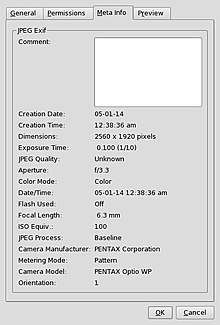
Metadata generated according to EXIF standards, describing a digital photograph
Metadata are structured assertions that describe some form of communication. Metadata are usually used to assist in the organization, discovery, use, and management of these communications.
Metadata can be machine-generated, human-generated, or generated by a combination of these approaches. Some examples of metadata:
- A library catalog card, which is a stuctured expression of information that describes a book and its content
- EXIF data as recorded by a digital camera or smartphone, which describe a digital photograph (see thumbnail on the right)
- ID3 metadata, which allows a song's title, artist, album, and track number to be stored within an MP3 file.
- CDWA records for works of art in museums.
- This page's history log, which documents all changes to the page you are viewing right now.
Contents
- Forms of Metadata
- Metadata Standards
- Uses of Metadata
- Metadata and Information Retrieval
Related Wikibooks
This article is issued from
Wikibooks.
The text is licensed under Creative
Commons - Attribution - Sharealike.
Additional terms may apply for the media files.